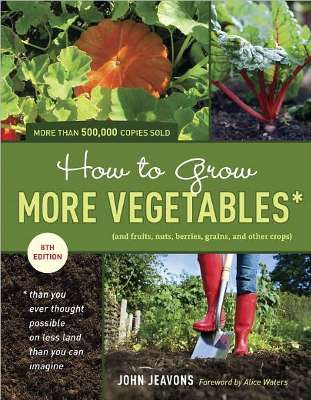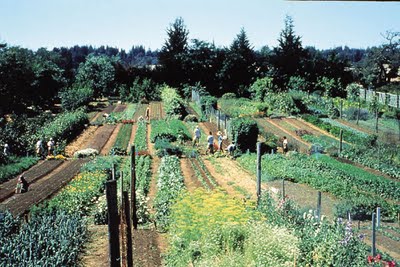
How to Grow More Vegetables
 How
to Grow More Vegetables by John Jeavons was an
interesting read, but I suspect it won't be as helpful to many backyard
growers as other gardening guides might be, mostly because How
to Grow More Vegetables is one of those books that
tells the "one true way" to garden. Rather than explaining the
science behind his gardening choices so you can pick bits and pieces to
apply to your own environment, the author assumes you will want to
completely mimic his GROW BIOINTENSIVE method in your garden.
How
to Grow More Vegetables by John Jeavons was an
interesting read, but I suspect it won't be as helpful to many backyard
growers as other gardening guides might be, mostly because How
to Grow More Vegetables is one of those books that
tells the "one true way" to garden. Rather than explaining the
science behind his gardening choices so you can pick bits and pieces to
apply to your own environment, the author assumes you will want to
completely mimic his GROW BIOINTENSIVE method in your garden.
(Yes, the term GROW
BIOINTENSIVE is in all caps throughout the book. Yes, this did
drive me a little nutty. No, I won't be repeating the term in all
caps throughout this post and those that follow.)
John Jeavons' method is
one he and his group, Ecology Action, have been polishing on their
California farm since 1971, when they heard about Alan Chadwick's
biointensive gardening tehcnique and decided to give it a try.
Chadwick had, in turn, compiled his own methodology from two sources:
the French-intensive
methods that have inspired others like Eliot Coleman, and Rudolf Steiner's
biodynamic system from the 1920s.
I'll write more about
the Grow Biointensive method (which is the term Jeavons coined for his
own offshoot) in later posts in this lunchtime series, but for now,
it's worth understanding the purpose behind his methodology.
Unlike the average backyard gardener who is primarily interested in
cutting costs and/or feeding her family the most delicious and
nutritious food available, Jeavons' plan is to save the world.
His goal is to reduce the land area, water, and petroleum required to
grow food so that we can fit many more people on the earth without
starvation. As a result, you'll see a lot of focus on calories
per square foot and much less emphasis on taste and nutrition.
 My final major peeve with
this book stems from the fact that biodynamic
practitioners and I have a different worldview. Jeavons doesn't write
about gnomes, but he does anthropomorphicize his plants ("Plants...do
like to have human companionship..."), and he includes information that
is dicey at best (such as his assertion that hummingbirds will hang
around to pollinate crops --- I can't think of any major vegetables
pollinated by hummingbirds). You'll find a chapter on planting by
the moon along with lots of unsupported companion-planting data, and
the scientific-minded reader will soon start to doubt the more relevant
parts of Jeavons' method due to their proximity to less scientific
assertions.
My final major peeve with
this book stems from the fact that biodynamic
practitioners and I have a different worldview. Jeavons doesn't write
about gnomes, but he does anthropomorphicize his plants ("Plants...do
like to have human companionship..."), and he includes information that
is dicey at best (such as his assertion that hummingbirds will hang
around to pollinate crops --- I can't think of any major vegetables
pollinated by hummingbirds). You'll find a chapter on planting by
the moon along with lots of unsupported companion-planting data, and
the scientific-minded reader will soon start to doubt the more relevant
parts of Jeavons' method due to their proximity to less scientific
assertions.
All of that said, the
book is worth a read with a critical eye if you're a serious gardener
and feel able to separate the wheat from the chaff. I'll include
a little of both in later posts this week.
| This post is part of our How to Grow More Vegetables lunchtime series.
Read all of the entries: |
Want more in-depth information? Browse through our books.
Or explore more posts by date or by subject.
About us: Anna Hess and Mark Hamilton spent over a decade living self-sufficiently in the mountains of Virginia before moving north to start over from scratch in the foothills of Ohio. They've experimented with permaculture, no-till gardening, trailersteading, home-based microbusinesses and much more, writing about their adventures in both blogs and books.
Want to be notified when new comments are posted on this page? Click on the RSS button after you add a comment to subscribe to the comment feed, or simply check the box beside "email replies to me" while writing your comment.

Hi Anna,
Its a nice book. I found a pdf of an earlier version this very good book which saved me from copying parts of it.
Also, check out Jacob MIttleider's stuff. He was being paid by governments to grow stuff where no one else could in various places around the world with GREAT success!
His 'Plant doctor' series and his other stuff is available as pdfs (which I converted from an old format for the current copyright owner).
A good soil test and plenty of Molybdenum seems to be his secret. I notice Jerry Bernetti also recommends at least 3 ppm of Mo.
warm regards,
John
You seemed to have picked up the same books last month as I did! First Grow Nutrient-Rich Vegetables, and now this one. I'm about half-way through the Solomon and his obsession with re-mineralization, but I haven't been able to bring myself to read this one. It may go back to Amazon. I discovered the author's habit of capitalizing GROW BIOINTENSIVE throughout the book and had to put it down. He's as bad as that Square Foot Gardening!(TM) guy. What's so difficult about giving some solid advice about gardening without branding yourself? Besides, IMO, thinking the moon has anything to do with gardening is lunacy (pun intended). sigh
The world of gardening has some interesting personalities, doesn't it?
I picked up a copy from the library after the post where you mentioned a number of the books you were reading. I skimmed it (couldn't read in depth; didn't have the attention for that.) I found the reference to other publications and pamphlets distracting and counterproductive. What I found most interesting was the experience that left them to believe that a truly sustainable system would dedicate 60% of land to carbon production (where grain could be a byproduct, but not necessarily), and then the subsequent allocations to calorie crops and nutrients/cash.
One of the take aways for me was that as a market gardener either the majority of land would be for compost, OR you just have to understand that buying in fertility would be required for intensive cultivation (and soil health.) For a backyard gardener with plentiful space, it might be possible to grow sufficient organic matter.
I actually might try their seed starting system (at least for some of the items.) I would still sow directly where it makes more sense, but thought that the flats might be an interesting alternative from the random tin cans and plastic cell flats. My intensity of backyard gardening would never thoughtfully require starting seeds in a flat that would have a deep taproot; might as well start in the garden what is best started in the garden.
I didn't even skim anything related to moon phases or companion planting. Just wasn't my cup of tea.